The making of the 90s Doom port for 3DO has long become the stuff of legend. A man who secured rights for it thought that you could just copy files from the PC version and add new weapons by uploading jpegs. Now people compare this story to fantasies about moving NFT items between different games.
On January 12, Stop Skeletons From Fighting’s Derek Alexander posted a tweet that went viral. It was dedicated to Randy Scott, who wanted to make Doom for 3DO in the 90s and failed.
What exactly went wrong?
- This story is not new as it was also told by developer Rebecca Heineman in 2016. We will share key details in case you have never heard of it.
- It all started in 1993 when Randy Scott decided to break into the games industry, having no experience at all. He managed to raise $100k from his friends at church and founded the company Art Data Interactive.
- Scott wanted to port Doom to 3DO and managed to secure rights from id Software for a whopping $250k.
- He started a marketing campaign in collaboration with 3DO at the end of 1994. Scott told about new weapons and levels and shared screenshots to gamers and the press. However, Art Data didn’t have anything ready at the moment.
- As far as Scott was concerned, you could port a game by basically copying files from the original disc to another system. He really believed in his venture’s success, but 3DO started to suspect that the project was somewhat flawed, to say the least.
- In July 1996, the company asked Rebecca Heineman for help. She was an experienced developer at the time, known as one of the founding members of Interplay Productions. Heineman’s portfolio included games like The Bard’s Tale III: Thief of Fate, Dragon Wars, and Wolfenstein 3D’s version for 3DO.
- In August, she agreed to work on the Doom port, not knowing what she was about to experience. 3DO wanted to ship the game before Christmas, so Heineman had only around 10 weeks to finish the port before the end of October.
- Art Data, meanwhile, assured that Doom for 3DO was 90% complete, with just a few bugs to fix. However, this was far from the truth.
- Randy Scott thought that the source code was just the retail copy of the original Doom. So Heineman had to contact id Software directly and get the source code of the game’s version for Atari Jaguar.
- When she was ready to start the development, one of Art Data employees told her that the company had nothing on its hands, and Randy was just lying.
- Heineman wanted to quit, but 3DO begged her to finish the job. As a result, she managed to port Doom from Jaguar to 3DO in only 10 weeks. Of course, she had no time for optimization, so the game’s performance was pretty bad.
- However, Randy Scott started to complain about technical issues and the lack of all those “new weapons” he talked about.
- “He did believe that if you drew a weapon — you just gave me the art file — I would put it in the game and it would magically fire bullets,” she recalled in an interview with Don’t Die. “It would do all the effects animations and switch and — he thought that was just me putting the art in there, hit ‘compile,’ and I’m done.”
- After the port was done, Scott showed his lack of experience and industry knowledge again. He printed 250k discs of Doom, which was the exact same number of 3DO consoles available in the market at the time.
- Despite Heinman’s efforts, nothing could save Doom’s version for 3DO. As a result, the game was poorly received by critics and players.
This is Randy. In the 90’s he bought the rights to Doom with plans to publish a 3DO port. He thought it just meant copy/pasting files from the PC disc. He was an idiot
When you say the blockchain and NFTs will let you put all characters into all games, you sound like Randy. pic.twitter.com/YyRLl2skpn
— Stop Skeletons From Fighting | ➕???????? (@stopskeletons) January 12, 2022
What does it have to do with NFTs?
While this story is not connected to the usage of blockchain in video games, people found a lot in common between Randy Scott and NFT evangelists.
“When you say the blockchain and NFTs will let you put all characters into all games, you sound like Randy,” Derek Alexander wrote.
Some users recalled the latest hot take by musician Mike Shinoda, who recently tried to defend in-game NFTs and said how much better they could make players’ lives. “In-game items are basically just NFTs you’re not allowed to sell or move out of the game,” he wrote on Twitter. “What if you could?”
???? That’s what’s so confusing to me. In game items are basically just NFTs you’re not allowed to sell or move out of the game. What if you could? https://t.co/L319by5daX
— Mike Shinoda (@mikeshinoda) January 8, 2022
Most people didn’t agree with Shinoda’s point of view, accusing him of the lack of knowledge and development experience. They compared the musician’s take to Randy Scott’s notion that you could create video games by making pictures and copying files.
The idea of moving NFTs between different games is now getting more popular. However, a lot of developers note that it is a very hard thing to implement, considering that different titles are built on different engines and technologies.
On top of that, it is hard to imagine big publishers allowing transferring in-game items to their competitors’ titles. Instead, they would like to have their own platforms, where they could collect fees from every transaction.

